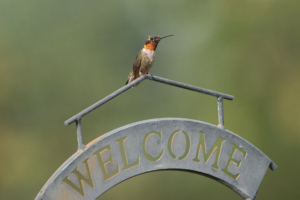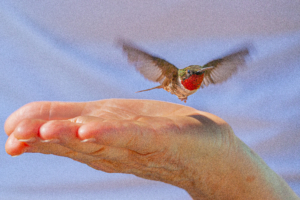
Article and photos by FMN Barbara Saffir
THEY’RE BAAAACCCCCKKK! Flying fairies — ruby-throated hummingbirds — returned to Virginia in April so now it’s time to invite some to your house or apartment. It’s easy and cheap. Just serve up some irresistible food and an inviting home. That means a clean hummer feeder, native plants, and nearby trees for them to eat, nest, and snuggle in. A water source is a huge plus for all birds and critters, especially to help them survive summer’s searing heat. And it’s also paramount to avoid insecticides in your yard since bugs are the main course and high-octane fuel for these feisty, flying jewels that can beat their wings about 53 times each second, according to Cornell’s respected “All About Birds” website. Ruby-throats are the only hummers that nest east of the Mississippi.
First the flowers. Even if you can’t plant salvia, cardinal flower, bee balm, coral honeysuckle, trumpet vine, or other hummer-magnets in time, or if you live in an apartment with a pint-sized balcony, you can still buy them in containers. It’s best to place them near your hummingbird feeders so they can slurp some sugar water for desert after gobbling down their bug buffet. Cornell says they especially love the bugs that humans sometimes hate, including disease-carrying mosquitoes, gnats, fruit flies, small bees, and spiders. And your local big box store is NOT the ideal place to buy hummer plants. Native plant nurseries appear to be the best sources for hummer-preferred flowers. When you go shopping, if you can, chose the plants with butterflies or hummers already feeding from them. And gobs of other wildflowers and flowering trees seduce hummingbirds, not just the ones you typically hear about. Virginia Tech offers some suggestions below.

Second, the feeders. All you need is a $4 hummingbird feeder (see below) and some plain white
granulated sugar. But NEVER hang any hummingbird feeders unless you’re willing to clean them every couple of days in the heat because dirty ones can form mold, fungus, bacteria, and fermentation, which can hurt or kill your hummers. The National Wildlife Federation says you need to refill the nectar “as often as every two days when summer temperatures remain above 90 degrees F. Rinse the feeder thoroughly—without soap—before refilling. Clean it once a month with a very mild, diluted bleach solution.” It also helps to hang the feeders from a ($4 and up) ant moat to prevent ants from monopolizing the nectar.
Don’t add anything to
Audubon’s standard nectar recipe: “The best (and least expensive) solution for your feeder is a 1:4 solution of refined white sugar to tap water. That’s ¼ cup of sugar in 1 cup of water. Bring the solution to a boil, then let it cool before filling the feeder.”
Hummers love water but ordinary bird baths are too big for little ruby-throats, which only reach 3.7 inches long and weigh 0.1-0.2 ounces, roughly the weight of a penny. Instead, they love to take showers in misting sprinklers and they sometimes flock to bubbling fountains, says
“The Spruce” website.
Male hummers (only adult males have full red throats and they only appear red in the sun due to the feather structure) start to return to Florida and Central America by August. But keep your feeders up through October because some young males and females are hungry stragglers. And when autumn rolls around, offer orange jewelweed wildflowers to your hummers. If you can’t wrangle up a supply, just stroll along the W&OD Trail by Hunter Mill Road or any other trail or garden with lush jewelweed and if you listen and watch carefully, I almost guarantee that you can find some happy hummingbirds.
TIP SHEETS:
AUDUBON’S HUMMINGBIRD FEEDER TIPS:
CORNELL UNIVERSITY’S GUIDE TO RUBY-THROATED HUMMINGBIRDS:
FIRST NATURE $4 HUMMINGBIRD FEEDER:
JOURNEY NORTH HUMMINGBIRD GUIDE:
LOWES’ ANT MOATS:
NATIONAL WILDLIFE FEDERATION’S HUMMINGBIRD TIPS:
PLANTNOVANATIVE TIPS:
THE SPRUCE’S WATER TIPS FOR HUMMINGBIRDS:
VIRGINIA’S NATIVE PLANT SOCIETYS’ GUIDE TO NATIVE NURSERIES:
VIRGINIA TECH’S HUMMINGBIRD PLANT RECOMMENDATIONS:




